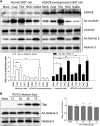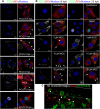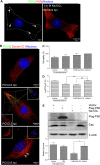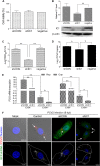Circovirus transport proceeds via direct interaction of the cytoplasmic dynein IC1 subunit with the viral capsid protein
- PMID: 25540360
- PMCID: PMC4325748
- DOI: 10.1128/JVI.03117-14
Circovirus transport proceeds via direct interaction of the cytoplasmic dynein IC1 subunit with the viral capsid protein
Abstract
Microtubule transport of circovirus from the periphery of the cell to the nucleus is essential for viral replication in early infection. How the microtubule is recruited to the viral cargo remains unclear. In this study, we observed that circovirus trafficking is dependent on microtubule polymerization and that incoming circovirus particles colocalize with cytoplasmic dynein and endosomes. However, circovirus binding to dynein was independent of the presence of microtubular α-tubulin and translocation of cytoplasmic dynein into the nucleus. The circovirus capsid (Cap) subunit enhanced microtubular acetylation and directly interacted with intermediate chain 1 (IC1) of dynein. N-terminal residues 42 to 100 of the Cap viral protein were required for efficient binding to the dynein IC1 subunit and for retrograde transport. Knockdown of IC1 decreased virus transport and replication. These results demonstrate that Cap is a direct ligand of the cytoplasmic dynein IC1 subunit and an inducer of microtubule α-tubulin acetylation. Furthermore, Cap recruits the host dynein/microtubule machinery to facilitate transport toward the nucleus by an endosomal mechanism distinct from that used for physiological dynein cargo.
Importance: Incoming viral particles hijack the intracellular trafficking machinery of the host in order to migrate from the cell surface to the replication sites. Better knowledge of the interaction between viruses and virus proteins and the intracellular trafficking machinery may provide new targets for antiviral therapies. Currently, little is known about the molecular mechanisms of circovirus transport. Here, we report that circovirus particles enter early endosomes and utilize the microtubule-associated molecular motor dynein to travel along microtubules. The circovirus capsid subunit enhances microtubular acetylation, and N-terminal residues 42 to 100 directly interact with the dynein IC1 subunit during retrograde transport. These findings highlight a mechanism whereby circoviruses recruit dynein for transport to the nucleus via the dynein/microtubule machinery.
Copyright © 2015, American Society for Microbiology. All Rights Reserved.
Figures








Similar articles
-
Dynein light chain DYNLL1 subunit facilitates porcine circovirus type 2 intracellular transports along microtubules.Arch Virol. 2017 Mar;162(3):677-686. doi: 10.1007/s00705-016-3140-0. Epub 2016 Nov 17. Arch Virol. 2017. PMID: 27858289
-
Adenovirus transport via direct interaction of cytoplasmic dynein with the viral capsid hexon subunit.Cell Host Microbe. 2009 Dec 17;6(6):523-35. doi: 10.1016/j.chom.2009.11.006. Cell Host Microbe. 2009. PMID: 20006841 Free PMC article.
-
HIV-1 Engages a Dynein-Dynactin-BICD2 Complex for Infection and Transport to the Nucleus.J Virol. 2018 Sep 26;92(20):e00358-18. doi: 10.1128/JVI.00358-18. Print 2018 Oct 15. J Virol. 2018. PMID: 30068656 Free PMC article.
-
Role of cytoplasmic dynein and kinesins in adenovirus transport.FEBS Lett. 2020 Jun;594(12):1838-1847. doi: 10.1002/1873-3468.13777. Epub 2020 Apr 13. FEBS Lett. 2020. PMID: 32215924 Review.
-
The association of viral proteins with host cell dynein components during virus infection.FEBS J. 2011 Sep;278(17):2997-3011. doi: 10.1111/j.1742-4658.2011.08252.x. Epub 2011 Aug 8. FEBS J. 2011. PMID: 21777384 Free PMC article. Review.
Cited by
-
Interactions of porcine circovirus 2 with its hosts.Virus Genes. 2016 Aug;52(4):437-44. doi: 10.1007/s11262-016-1326-x. Epub 2016 Mar 25. Virus Genes. 2016. PMID: 27016220 Review.
-
Revisiting Porcine Circovirus Infection: Recent Insights and Its Significance in the Piggery Sector.Vaccines (Basel). 2023 Jul 31;11(8):1308. doi: 10.3390/vaccines11081308. Vaccines (Basel). 2023. PMID: 37631876 Free PMC article. Review.
-
Cytoplasmic transport and nuclear import of plasmid DNA.Biosci Rep. 2017 Nov 29;37(6):BSR20160616. doi: 10.1042/BSR20160616. Print 2017 Dec 22. Biosci Rep. 2017. PMID: 29054961 Free PMC article. Review.
-
Epidemiological investigation of porcine circovirus type 2 and its coinfection rate in Shandong province in China from 2015 to 2018.BMC Vet Res. 2021 Jan 7;17(1):17. doi: 10.1186/s12917-020-02718-4. BMC Vet Res. 2021. PMID: 33413367 Free PMC article.
-
Structural insights into the assembly and regulation of distinct viral capsid complexes.Nat Commun. 2016 Oct 4;7:13014. doi: 10.1038/ncomms13014. Nat Commun. 2016. PMID: 27698405 Free PMC article.
References
-
- Biagini P, Bendinelli M, Hino S, Kakkola L, Mankertz A, Niel C, Okamoto H, Raidal S, Teo CG, Todd D. 2012. Circoviridae, p 343–349 InKing AMQ, Lefkowitz E, Adams MJ, Carstens EB (ed), Virus taxonomy: ninth report of the International Committee on Taxonomy of Viruses. Academic Press, London, United Kingdom.
Publication types
MeSH terms
Substances
LinkOut - more resources
Full Text Sources
Other Literature Sources
Molecular Biology Databases
Miscellaneous

